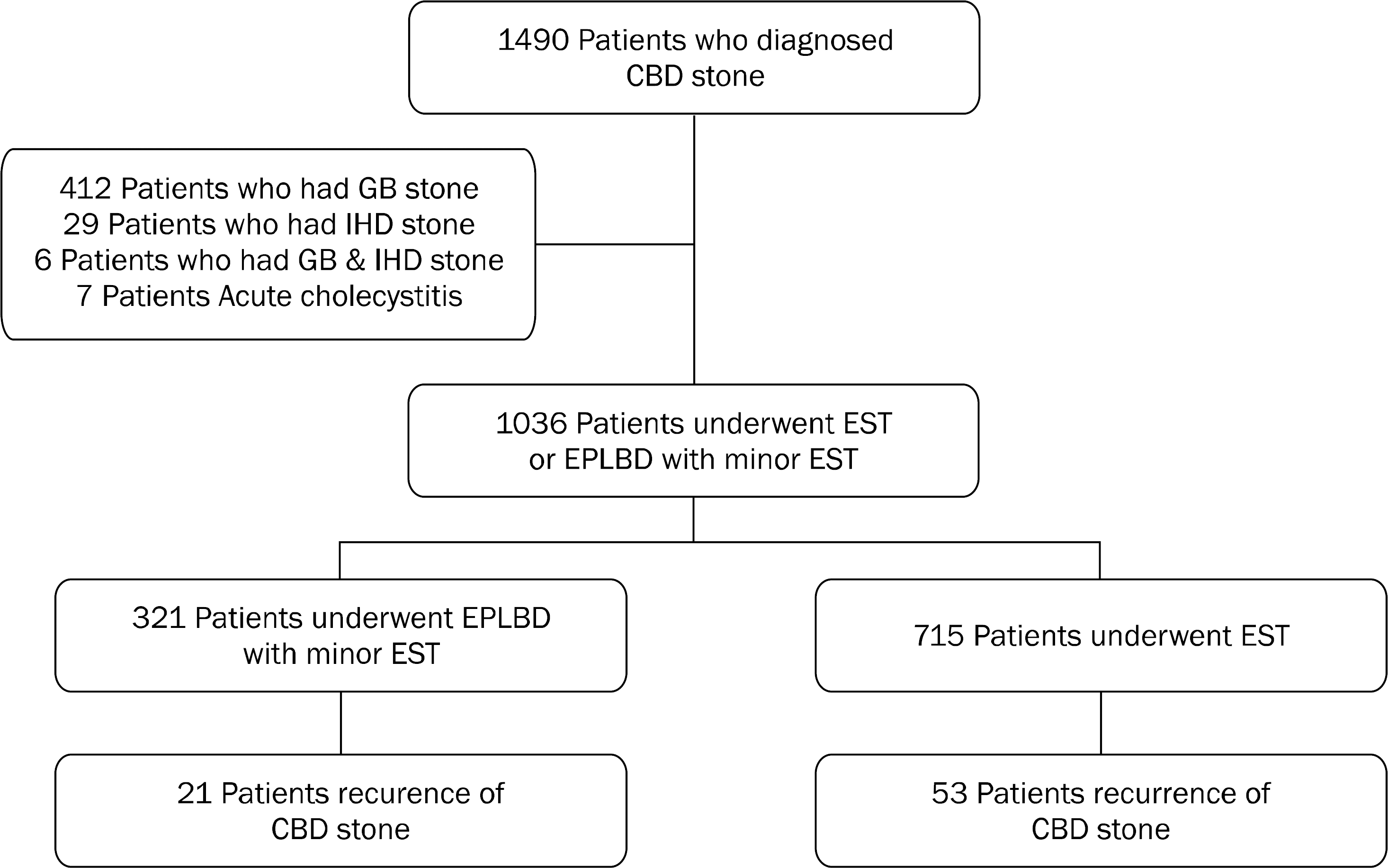Abstract
Background/Aims
Recent studies have reported the potentials of endoscopic papillary large balloon dilatation (EPLBD) with minor endoscopic sphincterotomy (EST) for the complete removal of common bile duct (CBD) stone in the high risk groups. However, there have been no reports about the recurrence of the CBD stone after EPLBD with minor EST. The aim of this study was to evlauate the recurrence of CBD stone after EPLBD with minor EST.
Methods
A total of 1,036 patients who underwent endoscopic treatment due to CBD stones at Pusan University Hospital were enrolled. The patients were classified into two groups: those who underwent EPLBD with minor EST (group 1) and those who underwent EST treatment (group 2). We investigated clinical factors and recurrence rate between two groups.
Results
The recurrence of CBD stone occurred in total of 74 patients (7%), and the recurrence rates of CBD stone were 21/321 (6.5%) in Group 1 and 53/715 (7.4%) in Group 2. There were no difference in the presence of diverticulum and the number and size of recurrent CBD stone between the two groups. In case of diverticulum existence, recurrence rates were 12/158 (7.6%) in Group 1 and 21/101 (20.8%) in Group 2. When compared to the case of no diverticulum existence (Group 1: 9/163 [5.5%], Group 2: 32/614 [5.2%]), the recurrence rate of CBD stone was significantly lower if treated after EPLBD with minor EST (p<0.01).
Conclusions
CBD stone that recurs after going through EPLBD with minor EST can be successfully removed with an endoscopic treatment. The recurrence of CBD stone was especially lower in cases with periampullary diverticulum and treated with EPLBD with minor EST. Our results will be helpful in endoscopic retreatment and preventing the recurrence of CBD stone.
References
1. Kawai K, Akasaka Y, Murakami K, Tada M, Koli Y. Endoscopic sphincterotomy of the ampulla of Vater. Gastrointest Endosc. 1974; 20:148–151.

2. Cotton PB, Lehman G, Vennes J, et al. Endoscopic sphincterotomy complications and their management: an attempt at consensus. Gastrointest Endosc. 1991; 37:383–393.

3. Freeman ML, Nelson DB, Sherman S, et al. Complications of endoscopic biliary sphincterotomy. N Engl J Med. 1996; 335:909–918.

4. Mathuna PM, White P, Clarke E, Merriman R, Lennon JR, Crowe J. Endoscopic balloon sphincteroplasty (papillary dilation) for bile duct stones: efficacy, safety, and follow-up in 100 patients. Gastrointest Endosc. 1995; 42:468–474.

5. Baron TH, Harewood GC. Endoscopic balloon dilation of the biliary sphincter compared to endoscopic biliary sphincterotomy for removal of common bile duct stones during ERCP: a meta-analysis of randomized, controlled trials. Am J Gastroenterol. 2004; 99:1455–1460.

6. Kim HG, Cheon YK, Cho YD, et al. Small sphincterotomy combined with endoscopic papillary large balloon dilation versus sphincterotomy. World J Gastroenterol. 2009; 15:4298–4304.

7. Lee SH, Hong SW, Cho YD, Cheon YK, Kim SG, Jang JY. The safety and effectiveness of medium endoscopic sphincterotomy with endoscopic papillary large balloon dilation for removing difficult common bile duct stones. Korean J Gastrointest Endosc. 2007; 35:80–86.
8. Ando T, Tsuyuguchi T, Okugawa T, et al. Risk factors for recurrent bile duct stones after endoscopic papillotomy. Gut. 2003; 52:116–121.

9. Kim DI, Kim MH, Lee SK, et al. Risk factors for recurrence of primary bile duct stones after endoscopic biliary sphincterotomy. Gastrointest Endosc. 2001; 54:42–48.

10. Keizman D, Shalom MI, Konikoff FM. An angulated common bile duct predisposes to recurrent symptomatic bile duct stones after endoscopic stone extraction. Surg Endosc. 2006; 20:1594–1599.

11. Kim MK, Kim MH, Lee TY, et al. Combined endoscopic sphincterotomy and large balloon sphincteroplasty for bile duct stones. Korean J Med. 2007; 73:474–480.
12. Hwang SJ, Kim YG, Lee KC, et al. Endoscopic sphincterotomy plus endoscopic papillary large balloon dilatation for large bile duct stones. Korean J Gastrointest Endosc. 2006; 32:184–189.
13. Prat F, Malak NA, Pelletier G, et al. Biliary symptoms and complications more than 8 years after endoscopic sphincterotomy for choledocholithiasis. Gastroenterology. 1996; 110:894–899.

14. Shin D, Moon D, Kim S, Hwang Y, Yun Y. The factors influencing the treatment results of residual & recurrent biliary stones. Korean J Hepatobiliary Pancreat Surg. 2002; 6:59–66.
15. Cheon YK, Lehman GA. Identification of risk factors for stone recurrence after endoscopic treatment of bile duct stones. Eur J Gastroenterol Hepatol. 2006; 18:461–464.

16. Kim MH, Myung SJ, Seo DW, et al. Association of periampullary diverticula with primary choledocholithiasis but not with secondary choledocholithiasis. Endoscopy. 1998; 30:601–604.

17. Chandy G, Hart WJ, Roberts-Thomson IC. An analysis of the relationship between bile duct stones and periampullary duodenal diverticula. J Gastroenterol Hepatol. 1997; 12:29–33.

18. Eggert A, Teichman W, Witmann DH. The pathological im-plication of duodenal diverticula. Surg Gynecol Obstet. 1982; 154:62–64.
19. Kubota K, Itoh T, Shibayama K, Shimada K, Nomura Y, Idezuki Y. Papillary function of patients with juxtapapillary duodenal diverticulum. Consideration of pathogenesis of common bile duct stones. Scand J Gastroenterol. 1989; 24:140–144.

Fig. 1.
Flow chart of study patients. EST, Endoscopic sphincterotomy; EPLBD, Endoscopic papillary large balloon dilatation; CBD, Common bile duct; GB, Gallbladder; IHD, Intrahepatic duct.

Table 1.
Baseline Characteristics of Patients (n=1,036)
Table 2.
Feature of Patients Who Had Recurrent CBD Stone (n=74)




 PDF
PDF ePub
ePub Citation
Citation Print
Print


 XML Download
XML Download